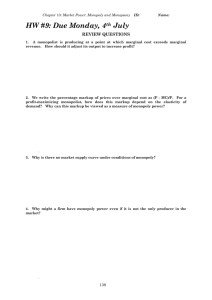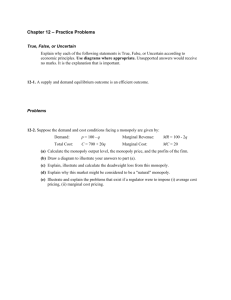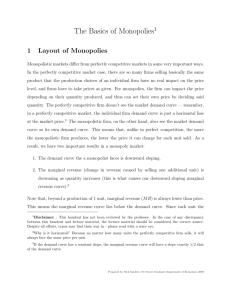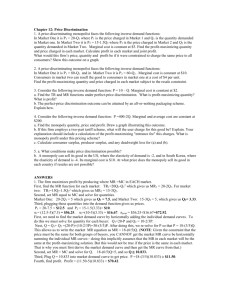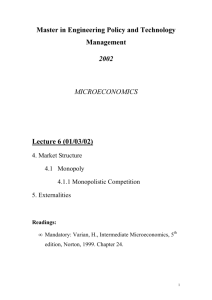R15
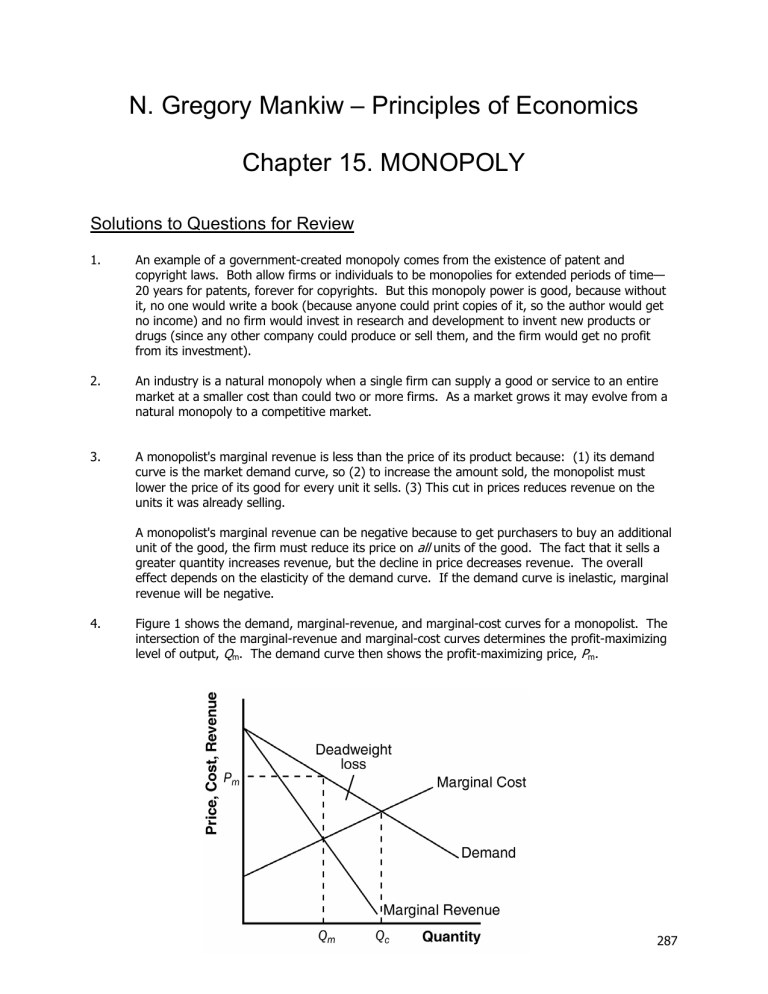
N. Gregory Mankiw – Principles of Economics
Chapter 15. MONOPOLY
Solutions to Questions for Review
1. An example of a government-created monopoly comes from the existence of patent and copyright laws. Both allow firms or individuals to be monopolies for extended periods of time—
20 years for patents, forever for copyrights. But this monopoly power is good, because without it, no one would write a book (because anyone could print copies of it, so the author would get no income) and no firm would invest in research and development to invent new products or drugs (since any other company could produce or sell them, and the firm would get no profit from its investment).
2. An industry is a natural monopoly when a single firm can supply a good or service to an entire market at a smaller cost than could two or more firms. As a market grows it may evolve from a natural monopoly to a competitive market.
3. A monopolist's marginal revenue is less than the price of its product because: (1) its demand curve is the market demand curve, so (2) to increase the amount sold, the monopolist must lower the price of its good for every unit it sells. (3) This cut in prices reduces revenue on the units it was already selling.
A monopolist's marginal revenue can be negative because to get purchasers to buy an additional unit of the good, the firm must reduce its price on all units of the good. The fact that it sells a greater quantity increases revenue, but the decline in price decreases revenue. The overall effect depends on the elasticity of the demand curve. If the demand curve is inelastic, marginal revenue will be negative.
4. Figure 1 shows the demand, marginal-revenue, and marginal-cost curves for a monopolist. The intersection of the marginal-revenue and marginal-cost curves determines the profit-maximizing level of output, Q m
. The demand curve then shows the profit-maximizing price, P m
.
287
6.
7.
Chapter 15
5.
8.
Figure 1
The level of output that maximizes total surplus in Figure 1 is where the demand curve intersects the marginal-cost curve, Q
Q c
and Q m c
. The deadweight loss from monopoly is the triangular area between
that is above the marginal-cost curve and below the demand curve. It represents deadweight loss, since society loses total surplus because of monopoly, equal to the value of the good (measured by the height of the demand curve) less the cost of production (given by the height of the marginal-cost curve), for the quantities between Q m and Q c
.
The government has the power to regulate mergers between firms because of antitrust laws.
Firms might want to merge to increase operating efficiency and reduce costs, something that is good for society, or to gain monopoly power, which is bad for society.
When regulators tell a natural monopoly that it must set price equal to marginal cost, two problems arise. The first is that, because a natural monopoly has a constant marginal cost that is less than average cost, setting price equal to marginal cost means that the price is less than average cost, so the firm will lose money. The firm would then exit the industry unless the government subsidized it. However, getting revenue for such a subsidy would cause the government to raise other taxes, increasing the deadweight loss. The second problem of using costs to set price is that it gives the monopoly no incentive to reduce costs.
One example of price discrimination is in publishing books. Publishers charge a much higher price for hardback books than for paperback books—far higher than the difference in production costs. Publishers do this because die-hard fans will pay more for a hardback book when the book is first released. Those who don't value the book as highly will wait for the paperback version to come out. The publisher makes greater profit this way than if it charged just one price.
A second example is the pricing of movie tickets. Theaters give discounts to children and senior citizens because they have a lower willingness to pay for a ticket. Charging different prices helps the theater increase its profit above what it would be if it charged just one price.
